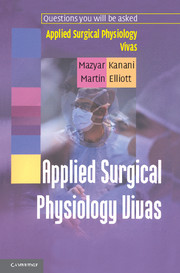Book contents
- Frontmatter
- Contents
- List of Abbreviations
- Dedication
- Preface
- A Change in Posture
- Acid-Base
- Action Potentials
- Adrenal Cortex I
- Adrenal Cortex II – Clinical Disorders
- Adrenal Medulla
- Arterial Pressure
- Autonomic Nervous System (ANS)
- Carbon Dioxide Transport
- Cardiac Cycle
- Cardiac Output (CO)
- Cell Signalling
- Cerebrospinal Fluid (CSF) and Cerebral Blood Flow
- Colon
- Control of Ventilation
- Coronary Circulation
- Fetal Circulation
- Glomerular Filtration and Renal Clearance
- Immobilization
- Liver
- Mechanics of Breathing I – Ventilation
- Mechanics of Breathing II – Respiratory Cycle
- Mechanics of Breathing III – Compliance and Elastance
- Mechanics of Breathing IV – Airway Resistance
- Microcirculation I
- Microcirculation II
- Micturition
- Motor Control
- Muscle I – Skeletal and Smooth Muscle
- Muscle II – Cardiac Muscle
- Nutrition: Basic Concepts
- Pancreas I – Endocrine Functions
- Pancreas II – Exocrine Functions
- Potassium Balance
- Proximal Tubule and Loop of Henle
- Pulmonary Blood Flow
- Renal Blood Flow (RBF)
- Respiratory Function Tests
- Small Intestine
- Sodium Balance
- Sodium and Water Balance
- Starvation
- Stomach I
- Stomach II – Applied Physiology
- Swallowing
- Synapses I – The Neuromuscular Junction (NMJ)
- Synapses II – Muscarinic Pharmacology
- Synapses III – Nicotinic Pharmacology
- Thyroid Gland
- Valsalva Manoeuvre
- Venous Pressure
- Ventilation/Perfusion Relationships
Muscle II – Cardiac Muscle
Published online by Cambridge University Press: 06 January 2010
- Frontmatter
- Contents
- List of Abbreviations
- Dedication
- Preface
- A Change in Posture
- Acid-Base
- Action Potentials
- Adrenal Cortex I
- Adrenal Cortex II – Clinical Disorders
- Adrenal Medulla
- Arterial Pressure
- Autonomic Nervous System (ANS)
- Carbon Dioxide Transport
- Cardiac Cycle
- Cardiac Output (CO)
- Cell Signalling
- Cerebrospinal Fluid (CSF) and Cerebral Blood Flow
- Colon
- Control of Ventilation
- Coronary Circulation
- Fetal Circulation
- Glomerular Filtration and Renal Clearance
- Immobilization
- Liver
- Mechanics of Breathing I – Ventilation
- Mechanics of Breathing II – Respiratory Cycle
- Mechanics of Breathing III – Compliance and Elastance
- Mechanics of Breathing IV – Airway Resistance
- Microcirculation I
- Microcirculation II
- Micturition
- Motor Control
- Muscle I – Skeletal and Smooth Muscle
- Muscle II – Cardiac Muscle
- Nutrition: Basic Concepts
- Pancreas I – Endocrine Functions
- Pancreas II – Exocrine Functions
- Potassium Balance
- Proximal Tubule and Loop of Henle
- Pulmonary Blood Flow
- Renal Blood Flow (RBF)
- Respiratory Function Tests
- Small Intestine
- Sodium Balance
- Sodium and Water Balance
- Starvation
- Stomach I
- Stomach II – Applied Physiology
- Swallowing
- Synapses I – The Neuromuscular Junction (NMJ)
- Synapses II – Muscarinic Pharmacology
- Synapses III – Nicotinic Pharmacology
- Thyroid Gland
- Valsalva Manoeuvre
- Venous Pressure
- Ventilation/Perfusion Relationships
Summary
1. Apart from the size of the fibres, what are the structural differences between skeletal and cardiac muscle?
structural differences:
Cardiac cells are mononuclear, skeletal muscle cells are multinuclear
The cardiac cell (myocyte) nucleus is centrally located, but peripherally located for skeletal cells
Cardiac muscle fibres are branched, unlike skeletal fibres
Cardiac cells are connected to one another by intercalated disks. Gap junctions at these discs allow excitation to pass from one cell to another. Therefore, cardiac myocytes contract as a syncitium
The T tubule system (which spreads the action potential) is larger in cardiac muscle
In cardiac muscle, such T tubules are located at the Z line. In skeletal muscle, it is located at the junction of the A and I bands
2. List some functional differences between skeletal and cardiac muscle.
Skeletal muscle is voluntary
Cardiac muscle contracts spontaneously (myogenic)
In skeletal muscle, Ca2+ is released from the SR following spread of depolarisation through the T tubule network
With cardiac muscle, Ca2+ -release from the SR is triggered by Ca2+ that already been released by the SR, and by Ca2+ that has influxed through membrane voltage channels. This is called Ca2+-induced Ca2+release
Mechanical summation and tetanus do not occur with cardiac muscle because of the longer duration of cardiac action potential
In the case of skeletal muscle, increases in force are generated by recruitment of motor units and mechanical summation (see ‘Skeletal muscle’)
The force of cardiac muscle contraction is determined by the amount of intracellular Ca2+ generated. For example through the action of hormones
[…]
- Type
- Chapter
- Information
- Applied Surgical Physiology Vivas , pp. 102 - 107Publisher: Cambridge University PressPrint publication year: 2004



